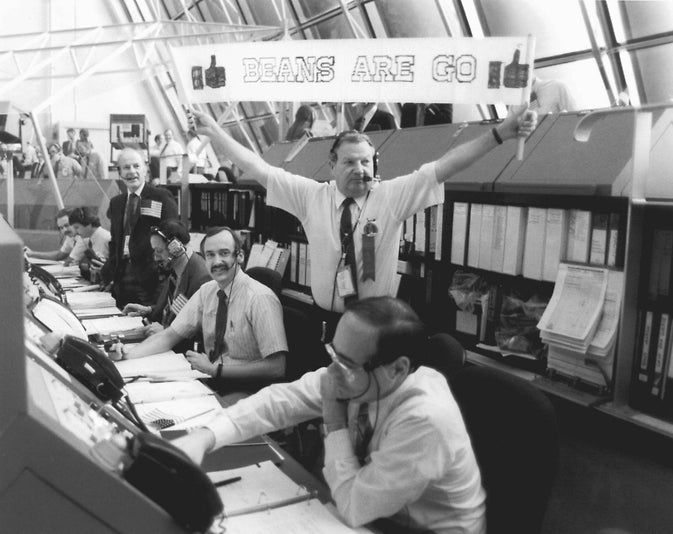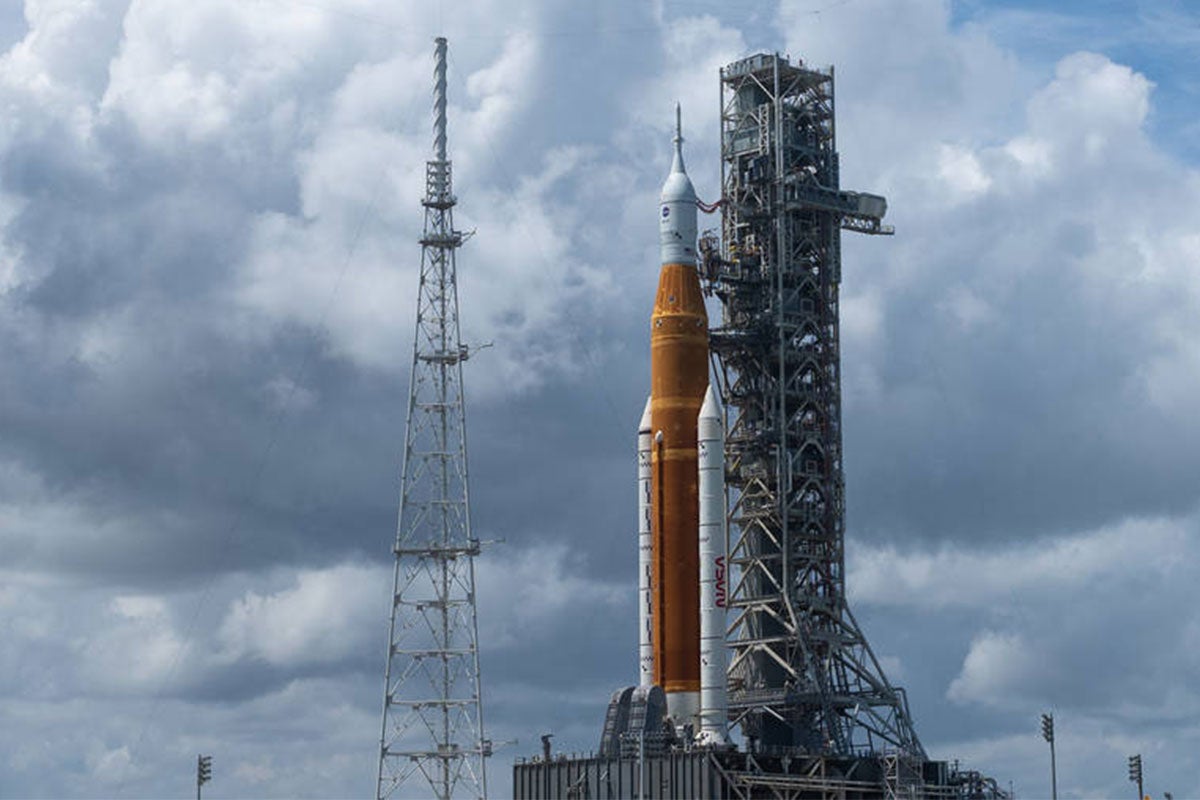When the Artemis 1 mission launch was scrubbed Sept. 3, it was an event UCF Planetary Scientist Phil Metzger ’00MS’05PhD has experienced dozens of times. Having worked on the Space Shuttle program Launch Team and with NASA for nearly 30 years, Metzger has seen — and worked through — his fair share of scrubbed launches, as he estimates 50% of the Space Shuttle program launches were canceled.

The uncrewed Artemis 1 launch has been scrubbed twice due to a liquid hydrogen leak on Space Launch System (SLS). The SLS is the most powerful in the world and was built for the Artemis program. Artemis aims to return humans to the moon by 2025, develop a sustainable presence there, and be a catalyst for deep space exploration to Mars and beyond.
With any launch NASA encounters issues and troubleshoots them in real time. Metzger notes that with a new rocket the likelihood for encountering issues is higher with the first launch attempt(s).
“There’s so many things that can go wrong and it takes years of work to get everything to the point that you’re ready to try to orchestrate it,” says Metzger, who shared his father worked on the Apollo program in an episode of UCF’s official podcast, Knights Do That. “I would say it’s really just the great numbers of things that can go wrong is the biggest challenge [with launches]. With every attempt, as [NASA] irons out these problems, the probability of launching gets higher and higher until eventually it’ll be high enough that they’re going to launch.”
NASA will make its third attempt for the Artemis 1 launch in October.
Here Metzger shares his insight from previous launch experiences on the considerations and challenges with launches and how NASA is constantly working to enhance safety.
How is the timing for launches determined?
It depends on the destination. So if they’re going to rendezvous with something in space, they have a certain launch window when the Earth is oriented in the correct direction. This mission, [NASA is] going to send some payloads around the moon, so they have to have the Earth oriented the right way so it can head off toward the moon. Because the moon is always right there, we don’t have a certain month of the year, we just have a certain hour of the day that we have to launch.
“There are always small things that are wrong, that break or aren’t functioning correctly, just like in your house.”
The other thing of course, is the technical status of the vehicle. Making sure everything is correct. There are some things on the vehicle that get too old. [NASA] can’t use them after they’ve been sitting on the vehicle for too long. And so they have a limited amount of time before they can launch, and then they would have to start changing some hardware out.
But the most important thing is just making sure the vehicle is ready, making sure all the main problems have been solved. Now, every time I was ever involved in the Space Shuttle program launches, you never had a perfect vehicle because it’s so complicated. There are always small things that are wrong, that break or aren’t functioning correctly, just like in your house. There’s always a number of things that aren’t working in the house. So they have waivers. They will go to a board and get approval to fly with certain problems not fixed. So when they decide to launch it’s because they’ve assessed everything, they’ve gotten all the waivers approved for things that aren’t 100% functional and they know that it meets what they call the launch commit criteria, meaning the vehicle’s in good shape and the weather is good.
What is the difference in preparing for a crewed launch, like Artemis 3, and an uncrewed launch, like Artemis 1?
In this case, I think they’re probably using the same rigor that they would on a crewed launch because this is a human-rated vehicle. NASA is going to fly a large, high-visibility rocket like this using the highest standards, whether the crew is on it or not.
“NASA is going to fly a large, high-visibility rocket like this using the highest standards, whether the crew is on it or not.”
But more generally, a commercial vehicle that doesn’t carry flight crew, they typically would have a much smaller launch team because there’s not as much politics riding on it. It’s an easier process to get a waiver in real time if they need to. Problems always pop up in every launch. So they have to deal with waivers, problem reports, and troubleshooting and correction of problems and waivers in real time throughout every countdown. For small, commercial uncrewed launches, that process would be a lot easier than on a large one, like NASA is going to be doing for this mission.
What are some other reasons launches get scrubbed?
We’ve had scrubs because of violations in the launch range where a ship or an airplane is going where it’s forbidden to go and it causes a threat. You could have hardware falling on the ship, or you could have something interfering with the launch. And we’ve also had delays of launch because of radio signals we’re picking up.
“You can get all kinds of things happening with radio signals interfering with the launch.”
On one launch, we were picking up a Spanish language broadcast from South America on the emergency frequency of the Space Shuttle astronauts’ parachute packs. The atmospheric conditions were making [the radio waves] bounce in the ionosphere and it was just coming in booming over our parachute radios. It was causing some delay. And so we couldn’t launch without verifying that their parachutes, if they had to evacuate the vehicle and parachute in an escape attempt, the ultra-high frequency radios have to be functioning so that we can find the crew and get them out of the ocean. You can get all kinds of things happening with radio signals interfering with the launch.
Of course, the weather. You don’t really want to launch in a lightning storm or if the upper-level winds are too high. There’s something called wind shear; as you’re going up, you’re passing through different layers of the atmosphere and one layer may have a lot higher wind than the layer just below it or just above it. And so if the wind shear is too high, then you can’t launch safely. Also ice crystals in upper atmosphere can cause electrostatics to form on the outside of the rocket. And so we’ve designed the rockets to be able to handle that, but sometimes things like ice crystals in the upper atmosphere might be a consideration. So there are a lot of different aspects of the weather that could affect the launch.
When NASA encounters issues on launch day, how do they determine whether they can fix it or if they need to scrub the mission?
There’s a giant book, it’s about seven, 3-inch-thick volumes of 8 ½ by 11 size pages. It’s like a whole shelf in a library with all of the contingency plans, and they call it procedure. What if this sensor goes bad? What if we get a leak on this pipe? They think through everything ahead of time and they’ve predetermined the troubleshooting plan for everything. They’re all published and on the shelf in the control room. So whenever there’s any problem, they flip open the page to the contingency procedure for that problem and they read through the troubleshooting steps.
Now, if they exhaust the troubleshooting steps and they haven’t solved the problem, then they would start doing real-time decision making. And that’s why they have these gigantic launch teams. They’re assessing in real time, can we solve this with the amount of time we’ve got left before we get to the end of the launch window? The launch window may depend on the orbital dynamics, the alignment of the moon with the rotation of the Earth, or it might have something to do with the vehicle.
“[Scrubbing a launch is] always a really tough, real-time decision, and it falls on the launch director ultimately to negotiate that.”
I don’t know about the SLS, but on the Space Shuttle, there were things called auxiliary power units. And once you turned them on, they started using up their fuel and you only had 15 minutes to launch. And if you couldn’t launch in that amount of time, you would have to scrub and then refuel those things for the next attempt.
The team has to present troubleshooting plans to the NASA launch director, who is the top-level person in the control room and gives the go-ahead to start implementing troubleshooting.
Sometimes the launch director will make phone calls and get approval to stretch the launch window by a few minutes. They’ll talk with Houston with the flight dynamicist. And I’ve been in launches where it comes down to the last second. [Scrubbing a launch is] always a really tough, real-time decision, and it falls on the launch director ultimately to negotiate that.
What happens after a launch gets scrubbed?
Over the next few hours, they’re still assessing how long the scrub needs to be. In their procedure book, they might have a 24-hour scrub option, a 48-hour option and an indefinite scrub option. And so they’re evaluating which one of these options are we going to follow.
“They try to figure out how to fix [problems] with the minimum impact on the overall schedule.”
And it all depends on how fast they can fix the problem. Sometimes they don’t know yet because they still have to do more troubleshooting. It might be a few hours until they get enough troubleshooting to find out, but as quickly as possible, they’re going to make the call how long the scrub is going to be. They’ll announce it all to the team. And so all the team is working that procedure.
Sometimes they have to roll the vehicle back to the VAB so they can get access to things to fix. Sometimes they can do the repair right there on the launchpad. They try to figure out how to fix it with the minimum impact on the overall schedule. As soon as the repair is done, they continue right on into the countdown and go forward with the next attempt.
What is it like being in the room on launch day? What happens after a successful launch?
It’s electric. There’s so much tension and excitement and concern, and you don’t even let go of the concern until after the vehicle engines have shut off in orbit. Once we say lift off, the people in the control room at Kennedy don’t have direct control on the vehicle anymore. At that point it’s controlled by Houston. So there would be some applause, but then they would quiet down again as we’re monitoring our systems, watching, making sure everything works all the way to orbit. And then there’d be applause again.
Now, I don’t know if they still do this, but I would bet anything they’re still doing this tradition. This tradition started way back [with the first Space Shuttle program launch in 1981]. After a successful, crewed launch, the whole flight team would go upstairs in the Launch Control Center for beans and cornbread. We would all force them in little plastic bowls and we’d all stand around eating beans and cornbread while we were all talking about the experience in this crowded hallway upstairs. It’s a cool tradition.





